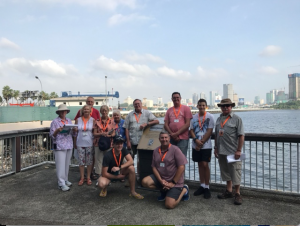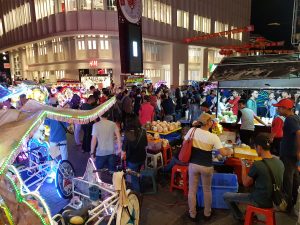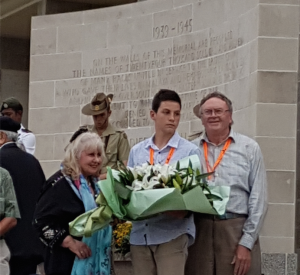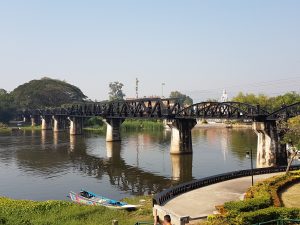The Australian 8th Division Commemorative Tour
By Boronia's expert battlefield guide, Rod Margetts
Last month I again had the pleasure of guiding another new Boronia battlefield tour in South-East Asia. This time it was a study of the Australian 8th Division experience in the Malayan campaign of 1941-42. The most commonly-held view of the men of the division is that they were prisoners of war for over three and a half years, working on the Burma – Thailand railway. Less well known is the brief, vicious campaign fought in Malaya, before the doomed defence of Singapore island. In planning the itinerary, my aim was to correct this gap in knowledge by exploring the entire experience of the division, in Malaya, on Singapore and, for the many who were sent there, on the railway.
The fractured nature of the division’s deployment to Malaya, and the fact that it fought dispersed and not as a division, brought some challenges. It was necessary to cover a bit of ground on the Malaysian peninsula, but we managed to visit and discuss all of the division’s engagements, from first contact with the Japanese, through the fighting withdrawal to Singapore.
After our first day visiting Endau and Mersing, the area of operations of the 22nd Brigade on the east coast, we spent the night in Kluang. This town featured not only in the wartime period, but also as a British base in the subsequent Malayan Emergency. From there we moved to Malacca for two nights. This was our base to visit and discuss the
The most commonly-held view of the men of the division is that they were prisoners of war for over three and a half years, working on the Burma – Thailand railway. Less well known is the brief, vicious campaign fought in Malaya, before the doomed defence of Singapore island. In planning the itinerary, my aim was to correct this gap in knowledge by exploring the entire experience of the division, in Malaya, on Singapore and, for the many who were sent there, on the railway.
The fractured nature of the division’s deployment to Malaya, and the fact that it fought dispersed and not as a division, brought some challenges. It was necessary to cover a bit of ground on the Malaysian peninsula, but we managed to visit and discuss all of the division’s engagements, from first contact with the Japanese, through the fighting withdrawal to Singapore.
After our first day visiting Endau and Mersing, the area of operations of the 22nd Brigade on the east coast, we spent the night in Kluang. This town featured not only in the wartime period, but also as a British base in the subsequent Malayan Emergency. From there we moved to Malacca for two nights. This was our base to visit and discuss the  major Australian actions in that area; the 2/30th Battalion ambush and battle at Gemas and the defensive battle at the Muar River and Bakri. Free time in Malacca allowed for visits to the old Dutch quarter, including a vibrant night market (pictured), and for shopping.
Next, we followed the fighting withdrawal of 27th Brigade units down the Trunk Road, stopping at the sites where the force attempted to delay the Japanese advance forward of Singapore. The stop at Parit Sulong, where the Australian and Indian wounded had to be left, and were subsequently massacred, was a poignant moment.
major Australian actions in that area; the 2/30th Battalion ambush and battle at Gemas and the defensive battle at the Muar River and Bakri. Free time in Malacca allowed for visits to the old Dutch quarter, including a vibrant night market (pictured), and for shopping.
Next, we followed the fighting withdrawal of 27th Brigade units down the Trunk Road, stopping at the sites where the force attempted to delay the Japanese advance forward of Singapore. The stop at Parit Sulong, where the Australian and Indian wounded had to be left, and were subsequently massacred, was a poignant moment.
 Crossing the causeway, as the withdrawal had done 75 years before, we settled into our Singapore accommodation for two nights. Our two days examining the 8th Division role in the island’s defence included visits to the 22nd Brigade area, where the main Japanese effort fell, the Malaya Command Headquarters bunker at Fort Canning and the Changi Prison Museum. We concluded the first part of the tour with attendance at the 75th Anniversary Commemoration of the surrender of Singapore, at Kranji Cemetery (pictured).
After farewelling some members of the group that night, the remainder flew to Bangkok next morning to begin the Thailand – Burma railway segment of the tour. Travelling to Kanchanaburi, we visited the Thailand – Burma Railway Centre Museum for a briefing on the railway, and the next part of the itinerary. The next two days found us following the course of the railway, north-west, to the Burmese border at Three Pagodas Pass, with stops at the various camp areas where Australian prisoners were held. This also provided an opportunity to experience the more remote Thai countryside and culture.
Crossing the causeway, as the withdrawal had done 75 years before, we settled into our Singapore accommodation for two nights. Our two days examining the 8th Division role in the island’s defence included visits to the 22nd Brigade area, where the main Japanese effort fell, the Malaya Command Headquarters bunker at Fort Canning and the Changi Prison Museum. We concluded the first part of the tour with attendance at the 75th Anniversary Commemoration of the surrender of Singapore, at Kranji Cemetery (pictured).
After farewelling some members of the group that night, the remainder flew to Bangkok next morning to begin the Thailand – Burma railway segment of the tour. Travelling to Kanchanaburi, we visited the Thailand – Burma Railway Centre Museum for a briefing on the railway, and the next part of the itinerary. The next two days found us following the course of the railway, north-west, to the Burmese border at Three Pagodas Pass, with stops at the various camp areas where Australian prisoners were held. This also provided an opportunity to experience the more remote Thai countryside and culture.
 The final two nights of the tour were spent at the Royal River Kwai Resort, on the riverside in Kanchanaburi. From here we explored the relevant sites in and around town, including the original Bridge on the River Kwai (pictured), with free time to return to the museum, or take an elephant ride in the national park. A farewell dinner at a floating restaurant, followed by transfers to Bangkok airport for homeward flights, concluded the tour.
My observations on the tour? This was the first time we ran this itinerary and I was very happy with the result. From the administrative aspect, the arrangements worked as intended; transport was safe and comfortable, and the accommodation was of a very high standard. As I said above, my aim was to convey a better understanding of the whole Malayan campaign, not just the aftermath. The 8th was the only Australian division ever to be surrendered. It has always concerned me that it is generally remembered for the period of captivity that followed, rather than for what was achieved in the period preceding the surrender. To think of them only as prisoners of war does a great disservice to those men.
The future? The part of our military history that this tour covers should be of great interest to all Australians. It is closer in time to the present day than the events of WW1, so there are many relatives of men of the division still very active. It is a story worth telling, and I would hope that there is sufficient interest to be able to provide this experience again.
Article written by Rod Margetts - who is a battlefield tour guide for Boronia Travel Centre.
The final two nights of the tour were spent at the Royal River Kwai Resort, on the riverside in Kanchanaburi. From here we explored the relevant sites in and around town, including the original Bridge on the River Kwai (pictured), with free time to return to the museum, or take an elephant ride in the national park. A farewell dinner at a floating restaurant, followed by transfers to Bangkok airport for homeward flights, concluded the tour.
My observations on the tour? This was the first time we ran this itinerary and I was very happy with the result. From the administrative aspect, the arrangements worked as intended; transport was safe and comfortable, and the accommodation was of a very high standard. As I said above, my aim was to convey a better understanding of the whole Malayan campaign, not just the aftermath. The 8th was the only Australian division ever to be surrendered. It has always concerned me that it is generally remembered for the period of captivity that followed, rather than for what was achieved in the period preceding the surrender. To think of them only as prisoners of war does a great disservice to those men.
The future? The part of our military history that this tour covers should be of great interest to all Australians. It is closer in time to the present day than the events of WW1, so there are many relatives of men of the division still very active. It is a story worth telling, and I would hope that there is sufficient interest to be able to provide this experience again.
Article written by Rod Margetts - who is a battlefield tour guide for Boronia Travel Centre.
This entry was posted in Media Releases. Bookmark the permalink.






